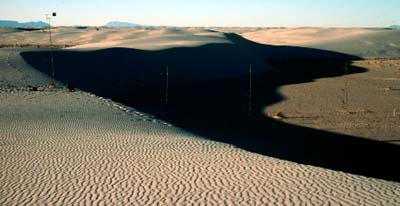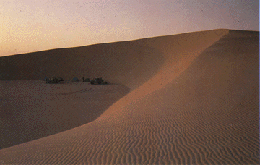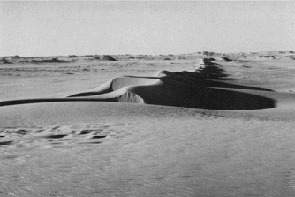
Transverse dunes- the wind direction goes over the top of the crest and not parallel along the ridge as seen with linear.
Image provided by kind permission of Dr. Shroder.
Morphology of Dunes
-depositional features
Dunes are the most important Aeolian landform, and they are accumulations of wind deposited particles and can take a variety of forms. They are a depositional landform as a result of Aeolian action.
There are 2 main types of dune:
Free Dune- form is primarily a function of wind characteristic. (described below)
Impeded Dune- morphology is influenced significantly by the effects of vegetation, topographic barriers or highly localised sediment source.
Transverse
Dunes that have a single slip face orientation are referred to as Transverse Dunes collectively. Transverse dunes are asymmetric and ridge like.
 |
Transverse dunes- the wind direction goes over the top of the crest and not parallel along the ridge as seen with linear. Image provided by kind permission of Dr. Shroder. |
They can be divided into:
Barcahnoid - These are arc shaped mounds of loose well sorted, very fine to medium sand. The upward slope is less than 15 degrees, and is wind packed and firm. The slipface/lee slope of the dune is unstable and loose sand, with an angle of about 30 degrees. It has two arms that extend from the main body of the dune or the mound. They range from 1 metre to 100's metres.
Barchan - Barchans are migratory, and the smaller barchans can move several cm's per year. The mega barchans are slower.
Compound barchan ridges can occur, where the large basal mound has a single proportional slip face and an upwind slope covered with smaller barchans or barchanoid ridges. They are all orientated in the same direction as the main dune. These compound type can be 1-2km horn to horn and reach heights of 30 metres or more.
 |
Barchan dune in Egypt showing that it is moving from right to left. Image provided from USGS |
Reversing
These are similar to linear dunes but they are classes as a transverse type dune. They are formed due to two prevailing winds blowing in opposite directions to the normal dune axis.
Linear
Linear Dunes are straight elongate ridges of lose well sorted very fine to medium sand. If the dunes are straight then they are ridges if they are sinuous then they are referred to as being seifs. The lengths of these structures is greater than the width, ranging from metres to kilometres. The surfaces on the lower flanks of both sides of the ridge are wind compacted.
Simple linear dunes- single ridges, where the slip faces are the same size and fixed by vegetation. Occur in semi arid deserts.
Compound linear dunes - form in drier regions, and secondary linear ridges found on the main ridges of the compound dunes are called seifs.
Complex dunes - basal linear ridges superposed by other dune types.
Overall linear dunes cover more desert area than any other dune especially in South Africa and the Sahara.
 |
This is a linear dune seen in Egypt. Image provided by USGS. |
Star
Star dunes are isolated pyramids of irregular shape, (but can in some cases be symmetrical) mounds of sand. They have 3 or more arms radiating from a central high point. The arms can vary in length, width, number and shape but each surface has a slipface.
Compound - More arms, some sinusoidal and are less regular with a less radial symmetry.
Complex - basal mound shape less regular
Star dunes can also occur as secondary elements on top of or as a combination with other dunes, especially complex linear or crescentic dunes. They can possibly signify a change in effective wind strength and direction.
 |
Star Dune- show that the wind direction was random and not unidirectional. Image courtesy of USGS |
Dome
These dunes show no external slip face. They may have evolved from star dunes, or even barchans if they reveal an internal slip face dipping in one direction.
 |
Dome dune from an aerial photo.
Image courtesy of Sharon L. Kanfoush |
Draa
A draa is a a high, more than 300m sand ridge or chain of dunes, lying about 0.5-5km from its nearest neighbour and moving at 2-5cm per year. It is the largest landform of the erg. A star shaped dune is developed where 2 draas chains cross.